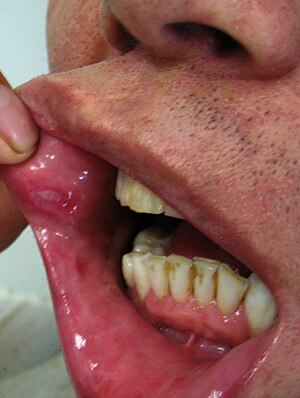Adamantiades-Behcet's syndrome
| Behçet's disease | |
|---|---|
| Synonyms |
|
 |
|
| Behçet's mouth ulcer | |
| Pronunciation | |
| Specialty | Rheumatology |
| Symptoms | Mouth sores, genital sores, inflammation of the eye, arthritis |
| Complications | Blindness, joint inflammation, blood clots, aneurysm |
| Usual onset | 20s to 40s |
| Duration | Long term |
| Causes | Unknown |
| Diagnostic method | Based on symptoms |
| Similar conditions | Reactive arthritis, Stevens-Johnson syndrome, Sweet syndrome |
| Medication | Immunosuppressive medication such as corticosteroids |
| Prognosis | Often goes away with time |
| Frequency | Rare (US, EU), more common (Middle East, Asia) |
| Classification |
· ·
|
|---|---|
| External resources |
Behçet's disease (BD) is a type of inflammatory disorder which affects multiple parts of the body. The most common symptoms include painful mouth sores, genital sores, inflammation of parts of the eye, and arthritis. The sores typically last a few days. Less commonly there may be inflammation of the brain or spinal cord, blood clots, aneurysms, or blindness. Often the symptoms come and go.
The cause is unknown. It is believed to be partly genetic. Behçet's is not contagious. Diagnosis is based on at least three episodes of mouth sores in a year together with at least two of the following: genital sores, eye inflammation, skin sores, a positive skin prick test.
There is no cure. Treatments may include immunosuppressive medication such as corticosteroids and lifestyle changes.Lidocaine mouthwash may help with the pain.Colchicine may decrease the frequency of attacks. The condition often improves with the passage of time.
While rare in the United States and Europe, it is more common in the Middle East and Asia. In Turkey, for example, about 2 per 1,000 are affected. Onset is usually in a person's 20s or 40s. The disease was initially described by Turkish dermatologist Hulusi Behçet in 1937.
Nearly all people with Behçet's disease present with some form of painful ulcerations inside the mouth. They are a form of aphthous ulcers or non-scarring oral lesions. The oral lesions are similar to those found in inflammatory bowel disease and can be relapsing. Painful genital ulcerations usually develop around the anus, vulva, or scrotum and cause scarring in 75 percent of the patients. Additionally, patients may present with erythema nodosum, cutaneous pustular vasculitis, and lesions similar to pyoderma gangrenosum.
...
Wikipedia
